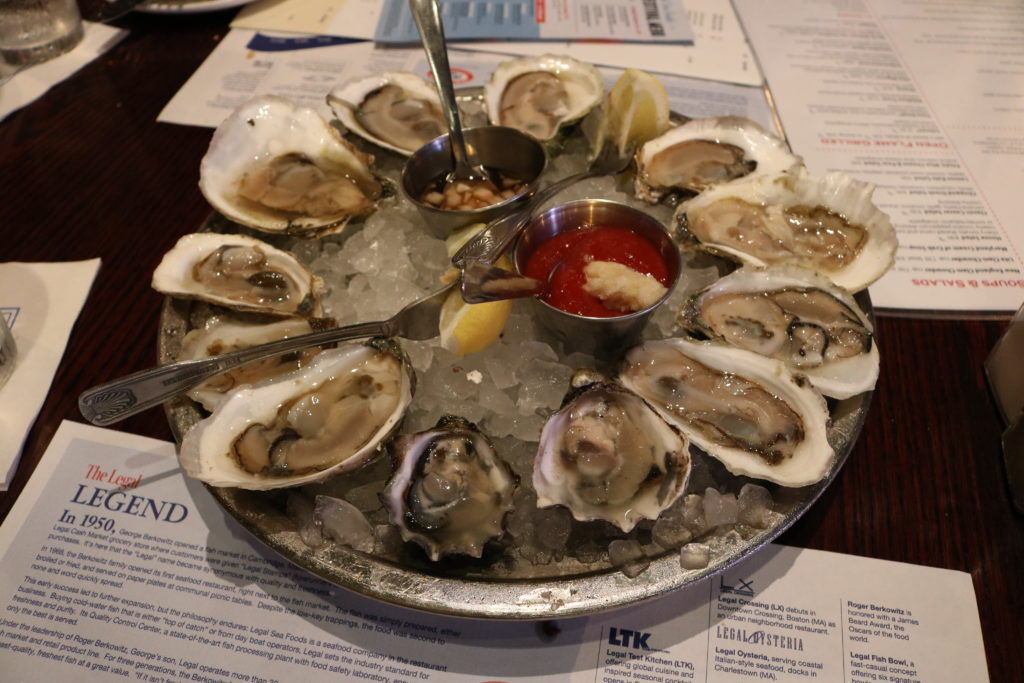It’s Oyster Season, Baby!
‘Tis the season for oysters in the District! Hurry in to Legal Sea Foods for their shell-shocking oyster festival that runs until October 9! You can feast on these bivalves in their raw form with oysters from coast to coast; baked in varieties like oyster scampi and crab and cheese; or fried and served buffalo or BLT style. The options are endless and the brine is FINE.

I sat down with corporate Chef Rich Vellante to debunk some of the most talked about oyster myths. Here’s what I found out:

Photo courtesy Legal Sea Foods.
1. How often are pearls found? If ever, what happens to them?
The oysters we serve in our restaurants are not farmed to produce pearls. It’s very rare to find a pearl in an oyster and, when you do, they certainly don’t look polished and perfect, like what you might expect. I have come across a handful of hard pebble-shaped pearls that are mistaken for pebbles.
2. Are oysters really aphrodisiacs? How many oysters does it take to really get you “in the mood?”
Because of the mineral boost, it does make you feel good when eating them. I enjoy at least a half-dozen.
3. Is it true that oyster season is best during months that end in “R”? If so, why? If not, what is the best oyster season?
I think there is some truth to that folklore. When you think about the months that end in “R” – September, October, November, December – they are months that have the optimal water temperature and nutrition levels for oysters. Sometimes during the dead of winter, the water forces the oyster to hibernate and in the summer months the water can get too warm. That doesn’t mean there aren’t good oysters all year round but, in a general sense, the “R” months are the sweet spot for oysters.
4. Can you explain to the readers how oysters are so high on the sustainability scale?
Most of the oysters we consume are farm-raised through government grants. The oyster farmers are able to project the demand and seed what is needed. It doesn’t fall into the category of over-harvesting because they are able to seed the amount needed to meet demand.
5. Can you elaborate on the importance oysters have for the Chesapeake Bay health?
Oysters are beneficial to all areas because they are natures filters. Each oyster can filter through 60 gallons of water a day. They help to remove impurities and bring specific areas like the Chesapeake back to its natural state. An abundance of wild oysters can also provide natural reefs for fish to habitat.

6. Describe some differences between small and large oysters. Is size mostly dependent on region that they’re found? Why do the brines differ?
Some oysters grow to a specific size and shape because of its species and how they are raised. And oyster size is also reliant on how long they are left to grow, water temperature and richness of nutrients in the water.
The biggest difference between a small and large oyster is just the amount of oyster which equates to mouthfeel. Larger oysters are more intimidating because they are more fleshy.
The brine of the oyster is dependent on water salinity and species. Some oysters taste like a salt lick, while others are more creamy, minerally or have a cucumber-like finish.
7. Top five ways to eat oysters?
How about six? Raw, fried, poached (oyster stew), escabeche, grilled in the shell and baked.
8. How do you make the perfect mignonette?
Keep it simple. I like minced shallots, champagne vinegar and cracked peppercorn
9. How frequent are your oyster shipments to ensure freshness? Are they all sourced local?
We have oysters shipped to us daily at our Quality Control Center in Boston. We quarantine them while we test them for purity (since they are nature’s filters) before we ship them to our restaurants. We procure the majority of our oysters from Maine and Cape Cod. Oysters from Rhode Island, Washington and Canada make frequent appearances on our menus as well.
10. How do you properly eat or “slurp” an oyster?
I personally like a squeeze of lemon, pick the shell up with my hand and slurp the oyster and its liquor into my mouth. A few light chews and down the hatch.
Can’t make it for the Oyster Festival? Check out the Oyster Riot events going on at Old Ebbitt Grill through November!
How do you like YOUR oysters?
Legal Sea Foods
704 7th Street NW
Washington, DC 20001
202-347-0007

